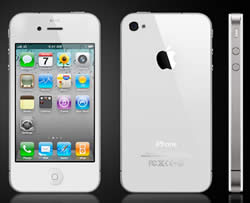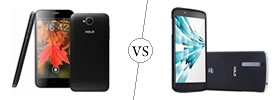Difference between iPhone 4 and iPhone 4S
Key Difference: The Apple iPhone 4 made huge waves when it was launched in June 2012 as the successor for iPhone 3GS. It was marketed with the intention of promoting video calling. The iPhone 4 offered a new design and incorporated an uninsulated stainless steel frame that acts as the device's antenna. The iPhone 4S was an update that was released after much anticipation in October 2011. It was the fifth generation of the iPhone and succeeded the iPhone 4. In terms of appearance, the phone resembles the iPhone 4 in many ways.
People are constantly changing their cell phones to keep up with new technologies and the companies release new phones to cater to the demand of the peoples. Technology is a dynamic sector that often changes and also requires people to constantly change and adapt to new and better things. People are also willing to shell out large amounts of cash to buy the latest and best phone on the market at that time. Hence, it is always best to compare different products and purchase the one that works the best according to a person’s need.
Though, Apple originally was assumed to have the most technologically innovative products, many other companies have stepped in to give it good competition. The Apple Company still has maintained a good standing ground in terms of innovation and technology. Apple has also successfully built a loyal fan base that is willing to purchase phones and tablets only by Apple and stand by their products a 100%. The iPhone 4 and iPhone 5 are two products that were launched by Apple. iPhone 5 is the successor and the latest model of the Apple’s smartphone flagship.

The Apple iPhone 4 made huge waves when it was launched in June 2012 as the successor for iPhone 3GS. It was marketed with the intention of promoting video calling. It also promoted other features such as consumption of media such as books and periodicals, movies, music, and games, and for general web and e-mail access. The iPhone 4 offered a new design and incorporated an uninsulated stainless steel frame that acts as the device's antenna. The iPhone 4 supports a 3.5 inch LED-backlit IPS LCD, capacitive touchscreen with 640 x 960 pixels and 16 million colors. The phone also offers safety features such as corning gorilla class as well as oleophobic coating that keep fingerprints off the front screen as well as the back screen. The phone was manufactured by LG under an exclusive contract from Apple. The iPhone 4 is available with iOS4 and is upgradable to iOS6.1. It includes a 1 GHz Apple A4 processor, PowerVR SGX535 GPU and 512 MB.
The phone is available with non-expandable 8, 16 or 32 GB internal storage capacity. The iPhone 4 was the first phone that supported two cameras with the ability for video calling. The phone was available with 5MP rear camera and VGA (0.3MP) front camera. It allowed people to use Wi-fi for video conferencing. The phone was offered with FaceTime, an application that allowed video calling by using either the front or the rear camera with another iOS device. The phone was also given a new design and was made sleeker, thinner with a flatter back compared to the older models.
 The iPhone 4S was an update that was released after much anticipation in October 2011. It was the fifth generation of the iPhone and succeeded the iPhone 4. In terms of appearance, the phone resembles the iPhone 4 in many ways. However, it has gained a few pounds in weight. The iPhone 4S offers improved hardware and software systems compared to its predecessors. The iPhone 4S retains the 3.5-inch LED-backlit IPS LCD, capacitive touchscreen along with the pixels. It weighs around 140 grams. The iPhone 4S also supported CDMA versions. The iPhone 4S was the first iOS device to offer a dual-core processor and was offered with the new iOS 5, which is now upgradeable to iOS 6.1.
The iPhone 4S was an update that was released after much anticipation in October 2011. It was the fifth generation of the iPhone and succeeded the iPhone 4. In terms of appearance, the phone resembles the iPhone 4 in many ways. However, it has gained a few pounds in weight. The iPhone 4S offers improved hardware and software systems compared to its predecessors. The iPhone 4S retains the 3.5-inch LED-backlit IPS LCD, capacitive touchscreen along with the pixels. It weighs around 140 grams. The iPhone 4S also supported CDMA versions. The iPhone 4S was the first iOS device to offer a dual-core processor and was offered with the new iOS 5, which is now upgradeable to iOS 6.1.
The phone is available with non-expandable 16, 32 or 64 GB internal storage capacity. It also upped the primary camera to 8 MP and bettered the video recording quality with additional features. One of the primary features that Apple launched with the 4S was Siri, Apple’s speech recognition software. It allowed users to control the phone using vocal commands and allowed the software to retain answers making it eerily human like. Siri was one of the main reasons for many people upgrading to the 4S. The 4S also offered a faster dual-core processor, more RAM and a slightly better battery. However, the faster processor sacrificed some standby time on the phone.
The information for the detailed table about the two phones has been taken from the Apple website and GSMArena.com.
|
|
iPhone 4 |
iPhone 4S |
|
Launch Date |
June 2010 |
October 2011 |
|
Company |
Apple Corporation |
Apple Corporation |
|
Size |
115.2 x 58.6 x 9.3 mm |
115.2 x 58.6 x 9.3 mm |
|
Display |
3.5 inches LED-backlit IPS LCD, capacitive touchscreen, |
3.5 inches LED-backlit IPS LCD, capacitive touchscreen, |
|
Screen |
640 x 960 pixels, (~330 ppi pixel density), 16M colors |
640 x 960 pixels, (~330 ppi pixel density) 16M colors |
|
Protection |
Corning Gorilla Glass, oleophobic coating |
Corning Gorilla Glass, oleophobic coating |
|
Weight |
137 g |
140 g |
|
2G Network |
GSM 850 / 900 / 1800 / 1900 |
GSM 850 / 900 / 1800 / 1900 CDMA 800 / 1900 |
|
3G Network |
HSDPA 850 / 900 / 1900 / 2100 |
HSDPA 850 / 900 / 1900 / 2100 CDMA2000 1xEV-DO |
|
GUI |
IUI |
IUI |
|
CPU speed |
1 GHz Apple A4 |
1 GHz Dual-core Cortex-A9 |
|
GPU |
PowerVR SGX535 |
PowerVR SGX543MP2 |
|
OS |
iPhone OS 4, upgradable to iOS 6.1 |
iOS 5, upgradable to iOS 6.1 |
|
Chipset |
Apple A4 |
Apple A5 |
|
RAM |
512 MB |
512 MB |
|
SIM Size |
microSIM |
microSIM |
|
Internal Memory |
8/16/32 GB |
16/32/64 GB |
|
Expandable Memory |
No |
No |
|
Sensors |
Accelerometer, three-axis gyro, proximity, compass, ambient light sensor. |
Accelerometer, three-axis gyro, proximity, compass, ambient light sensor. |
|
Connectivity |
Wi-Fi (802.11 b/g/n) (2.4 GHz only), Bluetooth 2.1 + EDR, micro-USB v2.0. |
Wi-Fi 802.11 b/g/n, Wi-Fi hotspot, Bluetooth v4.0 with A2DP, micro-USB v2.0. |
|
Data |
GPRS, EDGE, WLAN, Bluetooth and USB. |
GPRS, EDGE, WLAN, Bluetooth and USB. |
|
Speed |
HSDPA, 7.2 Mbps; HSUPA, 5.76 Mbps |
HSDPA, 14.4 Mbps; HSUPA, 5.8 Mbps |
|
WLAN |
Wi-Fi 802.11 b/g/n, Wi-Fi hotspot |
Wi-Fi 802.11 b/g/n, Wi-Fi hotspot |
|
Bluetooth |
Bluetooth v2.1 with A2DP |
Bluetooth v4.0 with A2DP |
|
USB |
micro-USB 2.0. |
micro-USB 2.0. |
|
Primary Camera |
5-megapixel iSight camera |
8 MP, 3264x2448 pixels, autofocus, LED flash |
|
Secondary Camera |
VGA, 480p@30fps |
VGA, 480p@30fps, videocalling over Wi-Fi and 3G |
|
Video |
HD (720p) up to 30 frames per second with audio |
1080p@30fps, LED video light, video stabilization, geo-tagging |
|
Camera Features |
Tap to focus video or still images, LED flash, Photo and video geotagging |
Touch focus, geo-tagging, face detection, panorama, HDR. Video mirroring and video out support |
|
Sound Enhancement |
No |
No |
|
Audio supported formats |
Audio formats supported: AAC (8 to 320 Kbps), Protected AAC (from iTunes Store), HE-AAC, MP3 (8 to 320 Kbps), MP3 VBR, Audible (formats 2, 3, 4, Audible Enhanced Audio, AAX, and AAX+), Apple Lossless, AIFF, and WAV |
Audio formats supported: AAC (8 to 320 Kbps), Protected AAC (from iTunes Store), HE-AAC, MP3 (8 to 320 Kbps), MP3 VBR, Audible (formats 2, 3, 4, Audible Enhanced Audio, AAX, and AAX+), Apple Lossless, AIFF, and WAV |
|
Video supported formats |
Video formats supported: H.264 video up to 720p, 30 frames per second, Main Profile Level 3.1 with AAC-LC audio up to 160 Kbps, 48kHz, stereo audio in .m4v, .mp4, and .mov file formats; MPEG-4 video up to 2.5 Mbps, 640 by 480 pixels, 30 frames per second, Simple Profile with AAC-LC audio up to 160 Kbps per channel, 48kHz, stereo audio in .m4v, .mp4, and .mov file formats; Motion JPEG (M-JPEG) up to 35 Mbps, 1280 by 720 pixels, 30 frames per second, audio in ulaw, PCM stereo audio in .avi file format |
Video formats supported: H.264 video up to 1080p, 30 frames per second, High Profile level 4.1 with AAC-LC audio up to 160 Kbps, 48kHz, stereo audio in .m4v, .mp4, and .mov file formats; MPEG-4 video up to 2.5 Mbps, 640 by 480 pixels, 30 frames per second, Simple Profile with AAC-LC audio up to 160 Kbps per channel, 48kHz, stereo audio in .m4v, .mp4, and .mov file formats; Motion JPEG (M-JPEG) up to 35 Mbps, 1280 by 720 pixels, 30 frames per second, audio in ulaw, PCM stereo audio in .avi file format |
|
Battery Capacity |
Non-removable Li-Po 1420 mAh battery |
Non-removable Li-Po 1432 mAh battery (5.3 Wh) |
|
Available Colors |
Black, White |
Black, White |
|
Messaging |
iMessage, SMS (threaded view), MMS, Email, Push Email |
iMessage, SMS (threaded view), MMS, Email, Push Email |
|
Browser |
HTML (Safari) |
HTML (Safari) |
|
Radio |
No |
No |
|
GPS |
A-GPS support |
A-GPS support |
|
Java |
No |
No |
|
Talk time |
Up to 7 hours on 3G, up to 14 hours on 2G (GSM) |
Up to 8 hours on 3G, up to 14 hours on 2G (GSM) |
|
Standby time |
Up to 300 hours |
Up to 200 hours |
|
Internet use |
Up to 6 hours on 3G, up to 10 hours on Wi-Fi |
Up to 6 hours on 3G, up to 9 hours on Wi-Fi |
|
Video playback |
Up to 10 hours |
Up to 10 hours |
|
Audio playback |
Up to 40 hours |
Up to 40 hours |
|
Additional Features |
|
|
Image Courtesy: techradar.com, clickbd.com









Add new comment